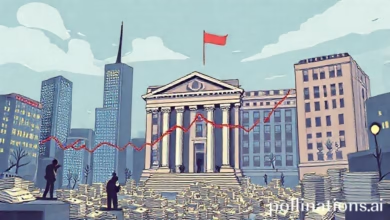Mastering Debt: Strategies for Personal and Economic Resilience

In today’s complex financial landscape, managing personal debt is more crucial than ever, not only for individual well-being but also for broader economic stability. High levels of personal and corporate debt can stifle economic growth, while poorly managed debt can lead to a cycle of financial stress for individuals. This article delves into effective strategies for managing and reducing personal debt, offering actionable tactics for those seeking a financial fresh start. We will explore how personal debt impacts economic growth and the intricate relationship between corporate debt and stock performance. Additionally, we’ll discuss the vital role of credit counseling, the nuances of negotiating with creditors for better repayment terms, and the risks and rewards associated with using debt for investment purposes. Lastly, we will examine how student loan debt shapes financial planning and how governments navigate national debt, highlighting the implications for the economy as a whole. By understanding these interconnected elements, readers will be better equipped to make informed financial decisions and foster a healthier economic environment.
- 1. **Effective Strategies for Personal Debt Management: Tactics for a Financial Fresh Start**
- 2. **Navigating the Debt Landscape: Understanding the Economic Impact of Personal and Corporate Debt**
- 3. **Debt Dynamics: Balancing Risks and Rewards in Investment and Financial Planning**
1. **Effective Strategies for Personal Debt Management: Tactics for a Financial Fresh Start**
Managing personal debt effectively is crucial for achieving financial stability and a fresh start. Here are several strategies that individuals can employ to regain control over their finances:
1. **Create a Comprehensive Budget**: A detailed budget is essential for understanding income, expenses, and debt obligations. By tracking spending and identifying areas for reduction, individuals can allocate more funds toward debt repayment.
2. **Prioritize Debts**: Use the avalanche or snowball method to prioritize debt repayment. The avalanche method focuses on paying off high-interest debts first, while the snowball method encourages paying off the smallest debts first to build momentum. Both strategies can reduce overall financial stress.
3. **Negotiate with Creditors**: Contact creditors to discuss repayment options. Many are willing to negotiate lower interest rates or establish flexible payment plans. A proactive approach can lead to more manageable terms and lower overall debt costs.
4. **Consider Debt Consolidation**: Combining multiple debts into a single loan with a lower interest rate can simplify payment processes and potentially reduce monthly payments. This strategy can be beneficial for those with high-interest credit card debt.
5. **Utilize Credit Counseling Services**: Professional credit counseling can provide valuable advice and resources for managing debt. Counselors can help create a personalized repayment plan and offer insights into budgeting and financial literacy.
6. **Build an Emergency Fund**: Setting aside funds for unexpected expenses can prevent reliance on credit cards or loans during financial emergencies. This buffer allows individuals to focus on debt repayment without incurring additional debt.
7. **Educate Yourself about Finances**: Understanding personal finance principles, including interest rates, credit scores, and investment options, can empower individuals to make informed decisions about managing debt and avoiding future financial pitfalls.
8. **Limit New Debt Accumulation**: While working to pay off existing debt, it's important to refrain from taking on new debt. This may involve reassessing spending habits and lifestyle choices to prioritize debt reduction.
By implementing these strategies, individuals can take significant steps toward reducing their personal debt and achieving a more secure financial future.
2. **Navigating the Debt Landscape: Understanding the Economic Impact of Personal and Corporate Debt**
Debt plays a crucial role in both personal and corporate finance, influencing economic growth and stability. On an individual level, high personal debt levels can lead to financial strain, affecting consumers' ability to spend and save. When individuals allocate a significant portion of their income to debt repayment, their discretionary spending decreases, which can slow economic growth. Moreover, high debt levels can lead to increased stress and mental health issues, further impacting productivity and economic participation.
In the corporate realm, debt can be a double-edged sword. Companies often rely on borrowing to fund expansion, invest in new technologies, or improve operations. When managed wisely, corporate debt can lead to increased profitability, greater market share, and overall economic growth. However, excessive corporate debt can pose risks, particularly during economic downturns. High debt levels can lead to financial distress, making companies vulnerable to bankruptcy and negatively influencing stock performance.
The interplay between personal and corporate debt also has broader economic implications. For instance, when consumers are burdened by personal debt, their reduced spending can lead to lower revenues for businesses, which may then struggle to meet their own debt obligations. This cycle can create a ripple effect, dampening economic growth and leading to job losses.
Understanding the economic impact of both personal and corporate debt is essential for policymakers and financial institutions. By promoting responsible borrowing and encouraging financial literacy, stakeholders can help mitigate the risks associated with high debt levels, ultimately fostering a healthier economic environment.
3. **Debt Dynamics: Balancing Risks and Rewards in Investment and Financial Planning**
Debt can be a powerful tool in investment and financial planning, but it carries inherent risks that must be carefully managed. When utilized effectively, debt can amplify returns, allowing individuals and businesses to pursue opportunities that might otherwise be out of reach. For instance, investors often use leverage—borrowing funds to invest in assets with the expectation that the returns will exceed the cost of borrowing. This strategy can lead to significant wealth accumulation; however, it also exposes investors to the risk of greater losses if the investments do not perform as anticipated.
Balancing the potential rewards of debt with its associated risks requires a clear understanding of one’s financial situation and a strategic approach to leveraging. Investors must assess their risk tolerance and ensure that they have a robust financial plan that includes contingencies for adverse market conditions. This might involve setting limits on the amount of debt taken on or maintaining a diversified portfolio to mitigate the impact of underperforming assets.
Moreover, the role of personal financial planning cannot be overstated. Individuals need to consider their long-term financial goals, cash flow, and the implications of debt on their overall financial health. For instance, while student loans may provide the necessary funding for education that can lead to higher earning potential, they also represent a long-term obligation that can influence other financial decisions, such as home buying or retirement savings.
Ultimately, the key to managing debt dynamics lies in informed decision-making. By weighing the potential benefits of leveraging debt against the risks involved, individuals and businesses can navigate their financial landscapes more effectively, fostering growth while safeguarding against the pitfalls of over-leverage.
In conclusion, effectively managing and reducing personal debt is crucial not only for individual financial health but also for broader economic stability. As we have explored, high levels of personal and corporate debt can hinder economic growth, highlighting the need for prudent debt management strategies. Negotiating with creditors for better repayment terms can provide immediate relief, while credit counseling offers structured support to navigate complex financial challenges.
Additionally, the decision to use debt as a tool for investment requires careful consideration of the associated risks and rewards, particularly in the context of student loans and their long-term impact on financial planning. On a larger scale, understanding how governments manage national debt and its implications for the economy can inform personal financial strategies and investment decisions.
Ultimately, by adopting effective debt management practices, individuals can not only achieve financial stability but also contribute to a healthier economic environment. As we move forward, it is essential to remain informed and proactive in addressing debt, fostering both personal resilience and economic growth.





